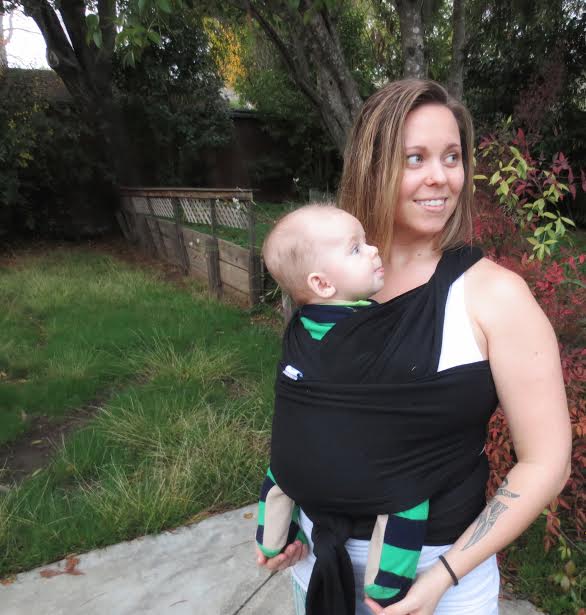
When my son was born, I was so excited to get to wear him everywhere we went and even just around the house.
I wanted to keep him close to me, and utilize babywearing for extra skin to skin time and bonding.
I had already bought a Moby wrap, and the first time I tried to use it was a disaster! I had no idea what I was doing and fumbled my way into getting it tied on with the help of my mom. After getting sufficiently tangled in it, I became so frustrated I ended up just taking it off and not even attempting to put my son in it.
Several YouTube videos later, though, I had finally tied the Moby wrap on successfully. Now to get my baby in it! I followed the tutorials closely and my baby screamed the entire time. I was so clumsy, trying to stuff this tiny, floppy infant into this strange contraption, and he could feel my awkward energy and was having none of it. Once I finally got him in, he was still crying, so right back out he came.
I borrowed different types of baby carriers from friends, tried my other carrier, the Beco Gemini (which we now love) that I had been given at my baby shower, and even bought a few other ones to try out in the hopes he would like one of them, but no such luck. This made things difficult for me because he wanted to be held all of the time and I never had a free hand.
Finally when he was a little over three months old, weighed 14 lbs, and had developed good neck strength and head control, I used my Beco Gemini carrier to let him face outwards rather than in towards my chest, and he loved it! This wasn’t a total surprise because he always wants to see whats going on around him. (Now I know that wearing my baby outward facing is less ideal than having him face inward because it can place more pressure on their spine and hips, but most ergonomic carriers lessen this potential.)
At least he was happy, and I was hands free!
Once he got used to being in the carrier I attempted using my Moby wrap again with him facing inward. I practiced tying it on and used one of his stuffed elephants to practice putting a “baby” into it. Once I got the hang of it and could get my son in and out of it quickly, he loved it!
I now wear him around my house often while I do chores, prep food, feed my dogs, and so forth. There are days he is much happier in the wrap than being anywhere else, and I can breastfeed him in it too. (Bonus!)
Benefits of babywearing:
1. Babies who are worn cry less.
Studies have shown that babies who are held and worn more cry less and are all around happier. Babies need to be close to their caregiver in order to feel supported. Newborns feel like they are back in the womb when they are worn correctly and are soothed by the sound of your breath and heartbeat. Older babies also get the benefits of feeling close to you, and they get a chance to look around and see what you see which helps them to learn about their environment.
2. Babywearing strengthens communication between parents and babies.
Babies become more attuned to your smell, facial expressions, movements, and even your emotions and energy. In turn, parents become more in tune with the needs of their babies and become better able to decipher their baby’s cues and what they mean. Being in such close proximity also initiates interaction. They become a part of your world.
3. Babies who are worn learn faster and are smarter.
As Dr. Sears, renowned Pediatrician says, “If infants spend less time crying and fussing, what do they do with their free time? They learn! Sling babies spend more time in the state of quiet alertness . This is the behavioral state in which an infant is most content and best able to interact with his environment. It may be called the optimal state of learning for a baby.”
When a baby is in a state of quiet alertness, they are able to soak up more of their surroundings. They learn from their environmental experiences and are able to participate in their parent’s world. A baby who is worn regularly becomes accustomed to, and learns from the sights and sounds of their surroundings and is not afraid of these sounds because he feels safe and secure against his caregiver. A baby who is left in a swing, on the ground, or in their crib hears the same noises but may be frightened by these unfamiliar sounds.
4. It is convenient.
Wearing your baby allows you to have two free hands to get things done. You can do the dishes, make lunch, do the laundry, the list is endless—all while wearing your child. Not only that, but the baby benefits from feeling the movements of their parent while being worn.
5. Babywearing reduces the risk of your child developing Plagiocephaly (flat head).
The more often a baby is worn and the less time they spend flat on their backs, the more round their head will stay. Babies who spend a lot of time on their backs in car seats, swings, in their crib or on the ground are at higher risk of developing a flat head which can lead to vision problems and developmental delays.
6. Babywearing encourages breastfeeding.
When a baby is worn close to their mother’s chest they are able to smell her milk, therefor encouraging them to want to breastfeed. This can be especially beneficial for preemies and babies who have had trouble breastfeeding.
What you can do to get your baby used to being worn:
1. Start early.
The sooner you start wearing your baby after birth, the better. They will grow accustomed to the feel of being worn and will enjoy feeling the closeness and security of your body, breath, voice, and heartbeat.
2. Try different carriers and methods of babywearing.
If one style doesn’t work for you or your baby, try a different one until you find one that works and is comfortable for both of you. There are a ton of different baby carriers, wraps, and slings available today.
3. Practice.
Some wraps and carriers have a higher learning curve than others. Practice putting it on and taking it off several times before you attempt to put your baby inside so that when you finally do, the transition is as smooth as possible. Many babies don’t like being put in a wrap or carrier if it takes too long, or if you are unsure of what you are doing. They can feel that uncertainty radiating off of you!
4. Make sure all of your baby’s needs have been met first.
Be sure your baby is clean, dry, and well fed before attempting to place them in a carrier, wrap, or sling. Starting while they are in a good, calm mood doesn’t hurt either!
5. Get moving.
As soon as your baby is in the carrier, go for a walk or start moving around. Often the movement will soothe your baby and they will settle down and begin to enjoy being worn.
6. Be patient.
If babywearing isn’t working at first, give your baby some time and wait till he or she is a bit older and can be carried in different positions. This could be a total game changer.
7. Seek help
Find a friend, midwife, nurse, fellow mama, or someone who is well versed in babywearing to teach you how to properly do so. This can be a huge help, especially for first time mamas.
My favorite organic and ergonomic baby carriers:
How you wear your baby is important. Babies who are worn incorrectly can develop hip displasia, spinal problems, and can become easily overstimulated. There are many carriers available that are designed to prevent such things. These are my top four favorite ergonomic baby carriers/wraps that best support both the wear and baby:
1. Beco Gemini
This is the carrier I use when I am out and about with my little man, on walks, and hikes. He loves it because he can face outward so easily while still being well supported and comfortable. This carrier is made from organic cotton, is machine washable, comfortable and supportive for both mom (or dad) and baby, and holds baby in an ergonomically correct position. Whats more, this carrier can be worn with baby facing inwards, outwards, on your hip, or on your back. The width of the seat is adjustable, and it does not require an infant insert either.
2. Ergo 360
This organic cotton baby carrier is similar to the Beco Gemini in that the Ergo 360 is also ergonomically correct, comfortable and supportive, and baby can be worn facing inward, outward, on your hip or on your back. An infant insert is required for babies under 12 lbs. It is also a bit pricier than the Beco. Many of my friends swear by this carrier.
3. Moby Wrap (organic)
I love my Moby wrap! We had a rough start, but now I use it every day to get things done around the house with my son wrapped snugly against me. When tied correctly and when baby is wrapped correctly, this carrier has excellent ergonomics. Unlike soft structured carriers, the wraps allow baby to be even closer to your body and wrapped closely up against you.
The Moby is versatile and your baby can be worn in several different positions. One downside is that the learning curve for how to use it is a bit steeper than other carriers, but once you get the hang of it, its great. I personally use the organic cotton Moby, but there are many great wrap carriers out there.
4. Lillebaby Complete Baby Carrier
This carrier has six ergonomic carrying positions, is made from 100 percent organic cotton, has good lumbar support, a hood to pull up over your baby for sun, wind, and cold protection, it has an extendable torso length for taller people (ideal for dads) and is machine washable.
~
Relephant:
Balancing Needs: The Downside of Attachment Parenting.
~
Author: Sarah Bradford
Editor: Catherine Monkman
Photo: Author’s Own










Read 0 comments and reply